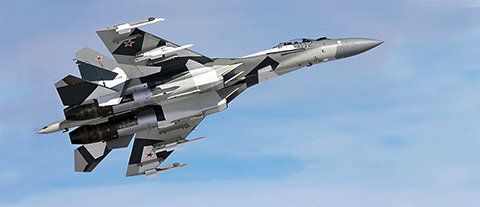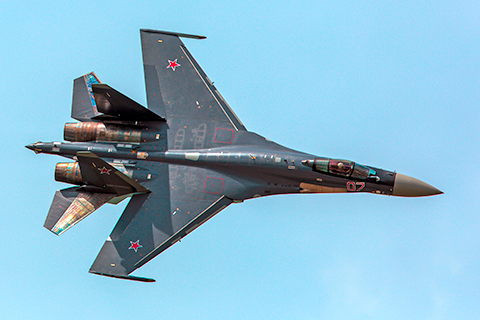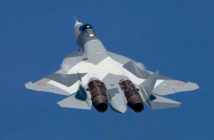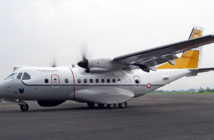By Jean-Michel Guhl

A demonstration model of the Sukhoi Su-35 fitted in air superiority guise with only four air-to-air missile. ©UAC
In a purely political move and a after a short facade competition, Indonesia finally decided on ordering from UAC in Russia a batch of sixteen Sukhoi Su-35 combat jets. Even if several foreign contenders were in line — Fighting Falcon, Gripen, Rafale and Typhoon — the final choice of the Indonesia Air Force (Tentara Nasional Indonesia-Angkatan Udara, TNI–AU) seems more than logical has it already operates Su-27 and Su-30 models. All these aircraft are in use with Skadron Udara 11 “The Thunders”, based in Makassar, South Sulawesi island, which flies a mix of Su-27SK/SKM and Su-30MK/MK2
The Su-35 are earmarked to reequip Skadron Udara 14 “The Eagles”, based at Maospati in East Java island, due to relinquish its old Northrop F-5E/F-5F Tiger IIs by 2016.

The Sukhoi Su-35 superbly exhibited in flight during the 2013 Paris Air Show. This machine was one of the first production aircraft of a 48 Su-35 batch ordered by the Russian Air Forces (VVS). ©UAC
The Su-35, which was exhibited at the 2013 Paris Air Show, is a deeply modernized variant of the legacy Su-27 “Flanker”. It is a powerful multirole fighter jet designed for intercepting and destroying all classes of aerial targets in ranged and close air engagements, fighting for air superiority as well as hitting ground and sea-surface targets including troops and ground infrastructure covered by anti-aircraft weapons and located at a considerable distance from its base airfield.
This airplane combines the qualities of a modern fighter (super-maneuverability, superior active and passive acquisition aids, high supersonic speed and long range, capability of managing battle group actions, etc.) and a good tactical airplane (wide range of weapons that can be carried, modern multi-channel electronic warfare system, reduced radar signature and high combat survivability). The high combat effectiveness of the Su-35 airplane is achieved through its:
– Ability to operate independently, in a group of airplanes or as part of a battle group controlled from an aerial, ground-based or ship-based command center;
– Single integrated information-management system providing intellectual support to the pilot, which maintains communication and coordination between the crew and avionics equipment;
– Covert attacks on radio-emitting aerial targets at mid- and long-range;
– Attacks on ground and sea-surface targets with guided high-precision missiles without entering air defense zones;
– High target-tracking stability;
– Simultaneous air-to-air and air-to surface operations.

An Indonesian Air Force Sukhoi Su-27SK air superiority combat jet belonging to Skadron Udara 11 pictured during a multinational exercise with the RAAF and USAF. ©ADF
For a very large country like Indonesia, stretched over hundreds of islands, it makes no doubt that the combat radius of the Su-35 and its late generation Irbis E radar with 400 km range will be unmatched. For UAC this contract comes as a real bonus, as it is the first ever export contracted by the company for its leading multirole combat jet.


